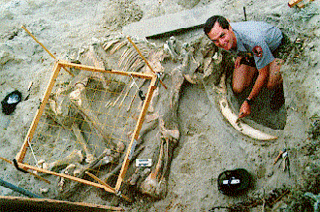
A little known but interesting aspect of Pleistocene megafauna was the species of pygmy mammoth (Mammuthus exilis) that inhabited the Northern Channel Islands of the California Coast. During the late Pleistocene when sea level was much lower than it is now, the four present northern islands (San Miguel, Santa Rosa, Santa Cruz, and Anacapa) were all part of a single large island geologists now call Santarosae. It is thought that Columbian mammoths (Mammuthus columbi) made their way to Santarosae about 20,000 years ago likely swimming (modern elephants are good swimmers!) the 5 miles or so from the mainland.
As sea level rose the mammoths were cut off from the mainland and the evolutionary response to decreasing food supplies and habitat was to select for smaller animals. The resulting pygmy species was about the size of a horse. You can see their size from the photo above, taken in an excavation conducted by Dr. Larry Agenbroad (see Steve's post below) for the National Park Service on Santa Rosa Island in the mid 1990s. This specimen was an adult male, with an estimated age in the 50s. He was so old he had bone spurs from arthritis on his feet. He was radiocarbon dated to about 12,800 years ago.
How the pygmy mammoths became extinct and exactly when is not yet firmly established. There is a theory that humans killed them off, as is surmised for the other North American mammoths and mastodons. Current research by Dr. John Johnson of the Santa Barbara Museum of Natural History at Arlington Springs on Santa Rosa Island has firmly established a human occupation out there as early as 13,000 years ago so it is likely their occupation of the islands overlapped. The SBMNH has documented 93 mammoth fossil locations on the islands so future work should help us answer that question.
Photo is courtesy of National Park Service - Channel Islands National Park
2 comments:
Insular dwarfism is pretty common. Not just those mammoths, but it also happened to another population of elephants on another Mediterranean island (can't remember which one, might have been more than one).
The opposite effect, insular giantism, which happens when a species gets to an island and can fit a larger-body niche, and has no competition to prevent it from achieving that size, also happens occasionally. Notably a large hedgehog from the miocene of Europe, a huge flightless owl from the pleistocene of cuba, and harpagornis, a gigantic eagle from the pleistocene of New Zealand.
I believe the little elephants were on Crete, and as you say possibly on others as well.
And I will be mentioning Harpagornis soon.
Post a Comment